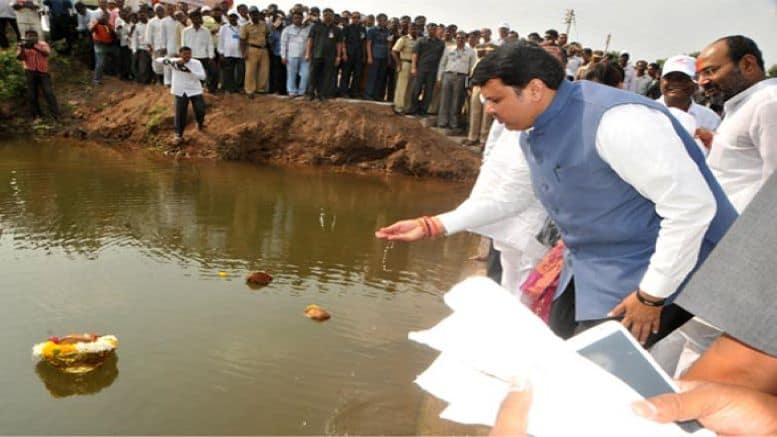Jalyukt Shivar Abhiyan (JSA), the flagship project of the Maharashtra government relaunched as JSA 2.0, is a government-people initiative aimed at providing a permanent solution to the annual drought situation in the Maharashtra interior. Originally introduced by the Fadnavis government in January 2015 this project caught national attention due to its sheer magnitude and extensiveness in bringing water empowerment to a vast region bereft of water. As a sustainable solution to raise the groundwater level and facilitate irrigation to vast areas where drought occurs every year for many decades, the project was replicated in Rajasthan, Gujarat, and Karnataka. During the MVA government, the Jalyukt Shivar Yojana was stopped along with most other development projects of the Fadnavis government but was revived by the Mahayuti government 1.0 on 3rd January 2023.
Maharashtra is the 3rd largest state of India, with agriculture being the main source of livelihood for its people in villages. With nearly 82% of the state marked as rain-fed, a large number of its villages, especially in the Marathwada and Vidarbha regions, are drought-prone due to uncertain and insufficient rainfall, adversely affecting living conditions and agriculture.
Immediately after swearing in, the Fadnavis government faced a major drought situation. In 2014, the average rainfall was down by 20 percent, leading to severe drought conditions in many villages and talukas of the state. The previous government declared 19059 villages in 22 districts hit by drought. The water storage in the state dam was depleted.
While the earlier governments always resorted to short-term measures or occasional financial aid to the farmers (mainly for political gains), it was Devendra Fadnavis who dared to take on the root cause of the problem i.e. acute shortage of drinking water and excess depletion of groundwater level in the vast region. This led to the concept of the Jalyukt Shivar Yojana based on several measures of water conservation, and he decided to go for it, despite it being a gigantic project with many uphill challenges.

Outline of the JSA scheme
Jalyukta Shivar Abhiyan, meaning water-sufficient farmlands, was launched on 26th January 2015. The initial target was to bring 25 Lakh hectares of land under irrigation. The program identified micro irrigation and rainwater harvesting as the main mechanisms and called for people’s participation in the execution of the project. The program is centered on connecting local water streams (or creating water channels where natural streams are not available) to larger water bodies to ensure an inward flow of water and then channel that water into micro water storage bodies near the place of use for conservation. It also emphasizes rejuvenating the existing water bodies and creating new ones in villages.
The different tasks under this project include:
- Broadening and deepening of river bases.
- Removing silt from lakes, ponds, farm ponds, and canals to prevent water percolation.
- Building check dams, canals, small ponds, and wells (individual and community).
- Rainwater harvesting.
- Arresting rainwater runoff in the drought prone areas.
- Creating awareness and encouraging people to use water efficiently for farming.
- Tree plantation.
Success statistics of Jalyukta Shivar Yojana 1.0
Between 2015 and 2019, according to a state Economic Survey report, the program created additional water storage capacity, making 19,655 villages permanently drought-free. An estimated 6,32,896 works were completed in 22,593 villages during the under JSA 1.0. By creating an aggregate water reservoir capacity of 27,08,297 TCM, 39,04,394 Hectares of land with irrigation potential was created, which resulted in 20,544 villages achieving 100% water sufficiency.
Effective implementation of the Jalyukt Shivar Scheme helped to stabilize the groundwater level despite insufficient rainfall. Apart from intercepting the rainwater in the villages through various means and draining it into the ground, removing the silt from the dams and giving them a new life helped in increasing the water level in the ground. During 2015-2019, a comparative study of the water level in the wells in the state revealed that the water level in the wells was 3.04 in 2014. It was seen as 3.60 in 2018. Increasing by 0.56%.
In some talukas of Vidarbha, the water level was increased from 0.66 to 1.56%. 3,511 works were done in 220 villages through Jalyukta Shivar Yojana 1.0 in Nagpur district. 3,320 of these works were completed and the rainwater harvested by these works provided abundant water for irrigation to the farmers. In the Wardha district, due to the revival of dead drains through the Jalyukt Shivar Abhiyan1.0, as well as the drain re-filling project, water is available for agriculture and drinking during summer.
In the Konkan region, new cement drains were constructed under the Jalyukta Shivar Yojana 1.0 in many talukas. At the same time, old cement drains were repaired. By removing the silt from the wells, Kolhapur-style dams were constructed at different places in the village, which helped farmers create orchards on more than 250 hectares of land in this area. Even summer crops could be harvested during the dry spells in May. Overall, this scheme helped to raise the groundwater level by 1 meter.
In the words of Devendra Fadnavis: ‘’When people consider any scheme as their mission or a movement it is bound to be successful, and the Jalyukt Shivar Yojana is the best example of this’’
How did the government ensure the participation of farmers in Jalyukt Shivar Abhiyan?
It’s crucial for any government program to get cooperation from the local community. Without the community’s understanding, the program’s goals won’t be achieved. The government raised awareness about the Jalyukt Shivar Scheme through various methods:
- By organizing village meetings known as gram sabhas.
- By holding early morning rallies, writing contests, art contests, and public speaking events to spread awareness among students.
- By utilizing electronic media for awareness campaigns.
- By providing informational booklets, pamphlets, and other materials about the program.
Glimpses of the execution plan of Jalyukta Shivar Abhiyan 2.0
According to a communication from the Chief Minister’s office:
- Projects will be carried out in the selected villages, which were not part of the initial phase. Likewise, in areas where the first phase of the Jalyukt Shivar Yojana initiative was carried out, yet more water is required. These projects will also be initiated with people’s involvement.
- Projects with costs exceeding Rs 3 lakh will be selected through an online bidding process. Additionally, all soil and water conservation projects will be cataloged and the updated maps will be made available on the Jio portal.
- Approval for work completion from both technical and administrative departments will follow the approval of the final layout by the village’s Gram Sabha.
- Following the implementation of the village plan, a report on the adequacy of water supply for the village will be compiled.
- Maintenance activities will be carried out on the projects that have been completed.
- Awareness will be raised among the public through a water education campaign conducted by the villagers.
Art of Living signs MoU with the Maharashtra government
Central to the agenda of Jalyukt Shivar Abhiyan 2.0 is optimizing the drainage systems to ensure a consistent water supply for agriculture. The Art of Living and the Department of Soil and Water Conservation, Government of Maharashtra, signed an MOU in Mumbai on November 26, 2023. By implementing comprehensive measures like Nala Kholikaran and Rundhikaran (desilting of Nalas to harness rainwater), which turn the nalas into effective water conveyance systems, the handshake seeks to assure water positivity for the farmlands in the state.
Government Resolutions (GR)
5 December 2014 – Water for All – Drought-Free Maharashtra 2019
7 February 2015 – formation of an empowered committee for effective implementation of the Jalyukt Shivar Abhiyan
10 June 2015 – Tree plantation during the monsoon under the Jalyukt Shivar Abhiyan program
8 December 2015 – River rejuvenation programs through public participation under the Jalyukt Shivar Abhiyan
4 May 2016 – Non-Government Organisations (NGO) active participation in Jalyukt Shivar Abhiyan program
28 September 2016 – Award for journalists for their excellent contribution to the Jalyukt Shivar Abhiyan Coverage
28 September 2016 – Award for active participation at district, Taluka and village level
26 October 2016 – Approval of the village action plan under the Jalyukt Shivar Abhiyan
31 December 2016 – Jalyukta Shivar Abhiyan implemented in C category Nagarpalika area
4 August 2017 – Form Transformation committee under Jalyukt Shivar Abhiyan
2 November 2017 – Active participation of private organisation and general people (PPP)
1 March 2019 – Extension of the implementation period for the Jalyukt Shivar Abhiyan
1 December 2020 – Open enquiry of works carried out under the Jalyukt Shivar Abhiyan
3 January 2023 – Implementation of Jalyukt Shivar Abhiyan 2.O

